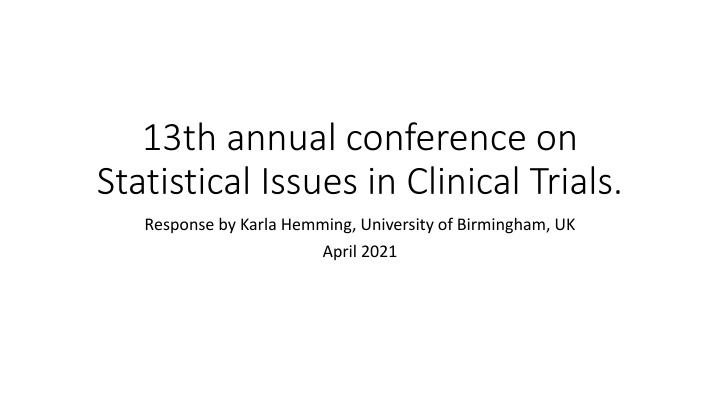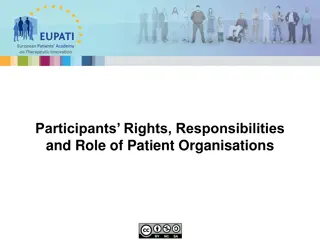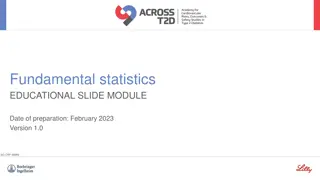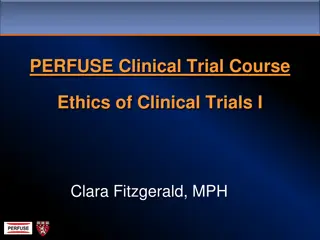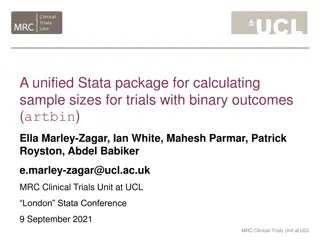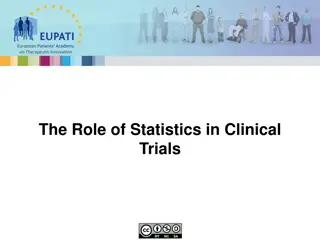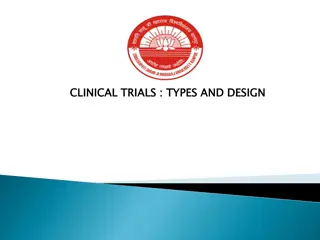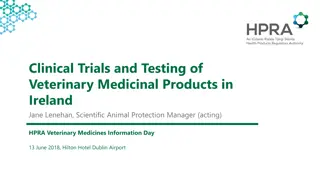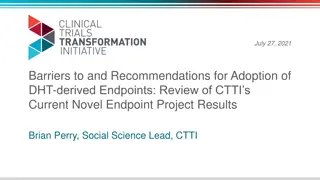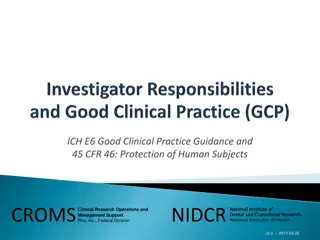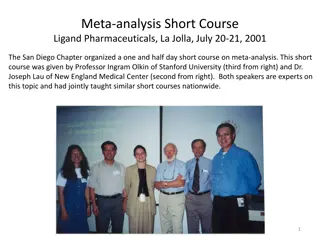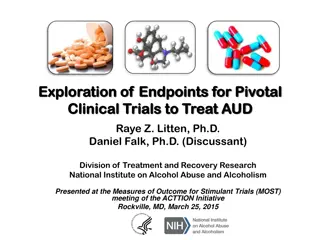Statistical Issues in Clinical Trials: Insights from 13th Annual Conference
The 13th annual conference on Statistical Issues in Clinical Trials covered topics such as penalties for extra variation and limited degrees of freedom, the Diet-Heart Hypothesis, controlled trials, unit of randomization, and causal inference. Speakers highlighted the importance of addressing clustering and degree of freedom corrections in clinical trial designs. The event emphasized the need for high compliance in individually randomized trials to establish causal hypotheses and capture total intervention effects, while cluster randomized trials offer pragmatic insights with lower compliance.
Uploaded on Sep 26, 2024 | 3 Views
Download Presentation

Please find below an Image/Link to download the presentation.
The content on the website is provided AS IS for your information and personal use only. It may not be sold, licensed, or shared on other websites without obtaining consent from the author.If you encounter any issues during the download, it is possible that the publisher has removed the file from their server.
You are allowed to download the files provided on this website for personal or commercial use, subject to the condition that they are used lawfully. All files are the property of their respective owners.
The content on the website is provided AS IS for your information and personal use only. It may not be sold, licensed, or shared on other websites without obtaining consent from the author.
E N D
Presentation Transcript
13th annual conference on Statistical Issues in Clinical Trials. Response by Karla Hemming, University of Birmingham, UK April 2021
Cornfield (1978) the two penalties of extra variation and limited df The earliest CRT paper in David Murray s list was Cornfield 1978. What are the two penalties : 1. Clustering 2. Degree of Freedom (DoF) correction How are we doing? 1. Almost all CRTs allow for clustering at design and analysis stage 2. Reviews reveals few CRTs make the DoF correction [Kahan 2016] What can be done? 1. Not all packages implement small sample corrections for all models 2. Simple adjustment to use t-distribution with K-2 DoF Cornfield J. Randomization by group: a formal analysis. Am J Epidemiol. 1978 Aug;108(2):100-2. Kahan, B.C., Forbes, G., Ali, Y. et al. Increased risk of type I errors in cluster randomised trials... Trials 17, 438 (2016).
CONTROLLED TRIALS OF THE DIET-HEART HYPOTHESIS: SOME COMMENTS ON THE EXPERIMENTAL UNIT Cornfield 1978 is part of a joint response with Sherwin 1978 on the diet heart hypothesis (DHH): 1. Does change in diet lead to reduction high lipids? 2. Does reduction in high lipids lead to a reduction in atheroma? 3. Does a reduction in atheroma lead to a reduction in CHD? Sherwin discusses: 1. Is this hypothesis correct? 2. How to evaluate if diet change interventions reduce CHD in practice? Sherwin R. Controlled trials of the diet-heart hypothesis: some comments on the experimental unit. Am J Epidemiol. 1978 Aug;108(2):92-9.
Sherwin 1978 and unit of randomisation Two types of RCTs considered in the evaluation of this causal hypothesis: 1. closed individually randomised trials in psychiatric institutions (presumably where the controlled setting allowed for full compliance in the 1960s / 70s) 2. open individually randomised trials in the general population where compliance would be less Sherwin proposed the CRT could be useful: 1. Feasibility / logistics 2. Indeed, one of the major hazards in individually randomized studies "contamination" among participants of different groups becomes a virtueamong members of a composite experimental unit.
Causal inference in CRTs Sherwin suggests: 1. To establish proof of the DHH hypothesis individually randomised trials with high compliance are necessary 2. To estimate the real world (i.e., with non compliance) effects of diet interventions CRTs are best placed to capture the total effects of interventions (direct and indirect) Sherwin s does not explicitly talk about pragmatic and explanatory effects, but it follows that (roughly): 1. Individually randomised trials ~ explanatory ~ high compliance 2. Cluster randomised ~ pragmatic ~ lower compliance Schwartz D, Lellouch J. Explanatory and pragmatic attitudes in therapeutical trials. J Chronic Dis. 1967 Aug;20(8):637-48
Spill-over Effects in Cluster Randomized Trials with Noncompliance Kang and Keele discuss spill-over effects in CRTs: 1. Use of de-worming has direct and indirect (spill-over effects) 2. In CRTs the IV analysis is unable to provide an estimate of the total (direct + indirect) CATE effects (~~~effect of receiving rather than offering treatment ~~ explanatory effect) 3. Under some assumption (that the treatment is not harmful?) can identify bounds on the total explanatory effect In the language of Sherwin: 1. The indirect effects is the type of contamination that becomes a virtue 2. Aligns with Sherwin s view that individually randomised trials are best placed to estimate explanatory effects test hypothesis and theory (differentiate total, indirect and direct effects) 3. CRTs allow feasible methods to test the impact of an intervention in the real-world setting where there will be compliers and non-compliers, and direct and indirect effects
Back to Sherwin 1978 When discussing the randomisation of entire States Sherwin considered the situation of each State devising their own intervention (to mange diet with a view to improving CHD). He tentatively suggested: 1. Randomise States to intervention or control 2. Intervention would be State specific Sherwin acknowledged the limitation of this design given the complexity and feasibility of randomising States 1. Sherwin did not mention a staggered roll-out in the form of a SW-CRT but he may have been only one step away from considering that as an option 2. Sherwin acknowledged that in pragmatic trials there may be much variation between cluster-level interventions and thus their effects
Cluster by treatment effects in SW-CRTs If every State devises their own intervention, that is the extreme of clusters adopting the intervention to suit their needs, this suggests: 1. Cluster by treatment effects could be very real in pragmatic trials 2. Time effects might also vary over clusters especially when clusters are very different and affected by differing external influences Hughes and Voldal suggest when it is not possible to model both time and cluster variations, the most important to consider are time variations, seems inherently intuitive (albeit with hindsight): 1. When clusters vary to the extent that their underlying secular trends are very different, misspecification of this underlying secular trend would confound treatment effects with secular effects 2. Whereas, when interventions vary across clusters, misspecification would seem to confound average effects with cluster-specific effects
And, what is the role of network science? it is the mark of a good amateur to know how to lose his racket in the presence of a professional. [Sherwin 1978 (discussing when CRTs are useful) handing the batten over to Cornfield 1978 (to discuss the statistical implications of CRTs)]
In summary Murray identified the top 50 influential papers in CRTs, at the top of this list was Cornfield 1978 which is clearly very influential Cornfield 1978 is interwoven with Sherwin 1978 These two papers raise and consider many of the issues we are still struggling with today
